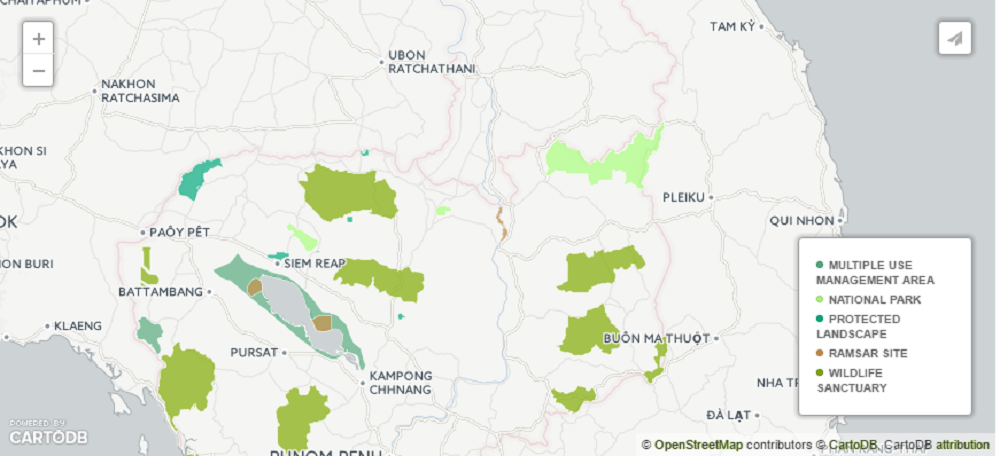Between 2009 and 2012, the Ministry of Environment went on nationwide leasing spree, signing over vast swaths of the country’s nominally protected areas to private companies for rubber plantations and other agribusiness ventures.
In the name of jobs and development, the companies have cleared tens of thousands of hectares of forest in and around their economic land concessions (ELCs), giving Cambodia one of the highest rates of deforestation in the world. As a show of his efforts to rein in the more wayward ELCs, Prime Minister Hun Sen announced in February that the government had taken back nearly 1 million hectares, a little less than half of the area leased out nationwide.
This week, the Ministry of Environment said the government would also begin removing some of the remaining ELCs from inside protected areas by redrawing and downsizing those areas.
And it has already started.
A new map of Cambodia’s protected areas shows the 36,000-hectare concession controlled by the Union Development Group (UDG) neatly carved out of Botum Sakor National Park in Kong Kong province.
Environment Ministry spokesman Sao Sopheap declined to explain the government’s reasons for downsizing the park in order to place the UDG concession outside its boundaries.
“I have no answer why the government decided that,” he said. “This is the government decision.”
The Chinese-owned UDG is building what it bills as a $3.8 billion eco-tourism complex on the site, although it has cut down much of the forest on its property in the process. It has also evicted more than 1,000 people in a long-running land dispute with local residents.
Mon Phalla, who heads the province’s environment department, said cutting the ELC out of Botum Sakor would make it easier to protect what remains of the park.
“It will be easier to manage,” he said. “Logging is not allowed in the protected area, so we need to protect it.”
There could be more to come.
Mr. Sopheap said the Environment Ministry was “of course” considering downsizing other protected areas in the same way.
He declined to say which ELCs or protected areas might be next, but said the Snuol Wildlife Sanctuary, which stretches across parts of Kratie and Mondolkiri provinces, was a contender.
The 75,000-hectare sanctuary is now a protected area in name only. The vast majority of it has been leased out to concession-holders who have cleared most of the trees the area had left. And while unique in its scale, Snoul is not alone. ELCs have wiped out the southern half of the Beng Per Wildlife Sanctuary east of the Tonle Sap lake and the northwest corner of the Kulen Promtep Wildlife Sanctuary in Oddar Meanchey province.
“The next step is to reassess” Mr. Sopheap said. “We have to assess the protected areas across the country…. We have to reflect the real situation.”
The spokesman did not explain how the government would go about choosing which ELCs to reon Thursdaymove. Officials at the Ministry of Agriculture, which recently took control of the Environment Ministry’s concessions, declined to comment.
At the same time that the Environment Ministry handed over its ELCs, it took control of all of the protected areas that had been under the jurisdiction of the Agriculture Ministry, adding nearly a third more land to the portfolio of an already woefully understaffed government body. And that’s on top of the 1 million hectares of new protected areas the government created just last month.
Naly Pilorge, director of rights group Licadho, said it made perfect sense for the Environment Ministry to refocus its resources on still-healthy forests and shed protected areas such as Snoul that have lost their conservation value.
“Following the recent transfer and creation of additional protected areas, it is imperative for the Ministry of Environment to come up with a management plan that will narrow down its effort to what is worth protecting,” she said. “Cutting out concessions that have already been planted is generally the right thing to do when the clearcutting has led to irreversible loss.”
Marcus Hardtke, who has worked with a number of conservation groups in Cambodia over the past two decades, agreed.
“The ministry has to concentrate efforts and resources on areas worth saving, primarily the large continuous forest blocks remaining and key ecological sites. If you pretend to protect everything, you most likely end up protecting nothing,” he said.
The Environment Ministry, however, should be careful not to excise concessions with healthy ecosystems, Mr. Hardtke said, or those that cover parts of protected areas that help connect one ecosystem to another—even if damaged.
“In some cases it would make sense to keep severely degraded plots and try to restore them to create corridors,” he said.
Mr. Hardtke said the ministry should also take care not to cut ELCs out of protected areas in a way that splits up healthy forests, and should cancel concessions already leased in such areas.
“Problems will occur if a protected area has been turned into a patchwork of small remnants of remaining forest,” he said. “Management would be very difficult, and chances are that these areas will experience death by a thousand cuts in the near future.”
[email protected], [email protected]
© 2016, The Cambodia Daily. All rights reserved. No part of this article may be reproduced in print, electronically, broadcast, rewritten or redistributed without written permission.
Image from Open Development Mekong. Visit for maps and datasets.





